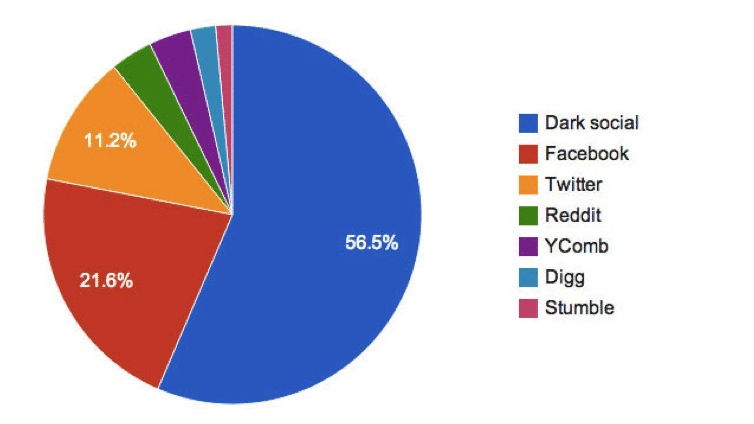I won’t apologize for the clickbait title, because it’s true. And lots of different people completely agree. The idea may seem jarring, but once you dig into dark social it isn’t that surprising. A good chunk of social referrals are simply difficult to track, so Google Analytics lumps it into other categories. What is dark social, why doesn’t Google track it, and what does it mean my for my brand?
Dark Social: We Have the Whole History of the Web Wrong – The Atlantic
What is Dark Social?
Putting aside the intimidating name (coined by Alexis Madrigal in 2012 for this piece from The Atlantic), dark social is a channel you use every single day, and have for decades. You’ve likely used dark social longer than traditional social media. Remember AOL Instant Messenger, MSN Messenger, IRC, eMail, Facebook Messenger, WhatsApp, even SMS? All of these are dark social. It includes of your messengers, messaging apps, mobile apps, and similar sources. Every time you share a URL via copy and paste (outside of traditional social channels) you are using dark social. So what makes them different than traditional media, and why can’t we track them?
Parallel Path Internal Data Analysis
Why doesn’t Google track it?
Typically when you’re on Facebook and click on a Top 10 Cats of All Time article from Buzzfeed your browser attaches a little extra data with your click. It tells Buzzfeed that you saw the article on Facebook and clicked on it. Marketers and Google can easily track most channels like Google Search, Social Media, Advertising, and Direct. Direct means someone either bookmarked your site, or typed the URL directly into their browser. But there are two problems:
First: Messengers and similar apps don’t (and often can’t) send that little extra data to websites, so Google Analytics won’t know where the user came from.
Second: Google Analytics always displays New Users who are Direct Traffic to Long/Complicated URLS. This means that Google thinks someone who has never been to your site magically bookmarked http://www.example.com/product/shoe1/ex?pid=4&zid=4q or that they typed that directly into their address bar. Neither of those options are plausible at all, so why does so much traffic follow that pattern? For example, according to Google, 309 new users typed this 75 character URL directly into their address bar, or created a bookmark without even going to the website!
The cause of this error is dark social. These users followed a link someone had messaged to them, in a way Google couldn’t track. There is no way to tell where the users came from, and it appears as though they were direct users. Google groups them into the direct channel, even though we know this is incorrect.
What does this mean for my brand?
Social is more important than you think. Even if your brand isn’t on Facebook, Twitter, or LinkedIn (you should be!), social still plays a strong role in driving traffic to your site. If you want to identify users coming from dark social to your site, you can follow a couple easy steps.
With messaging apps on the rise, the importance of dark social is growing stronger. Expect to see some services offering to track this data as well as Google giving it a try too. But without a technological shift in the way messengers and apps work, we’ll never know exactly where these users are coming from. A win for privacy, a loss for marketers.



